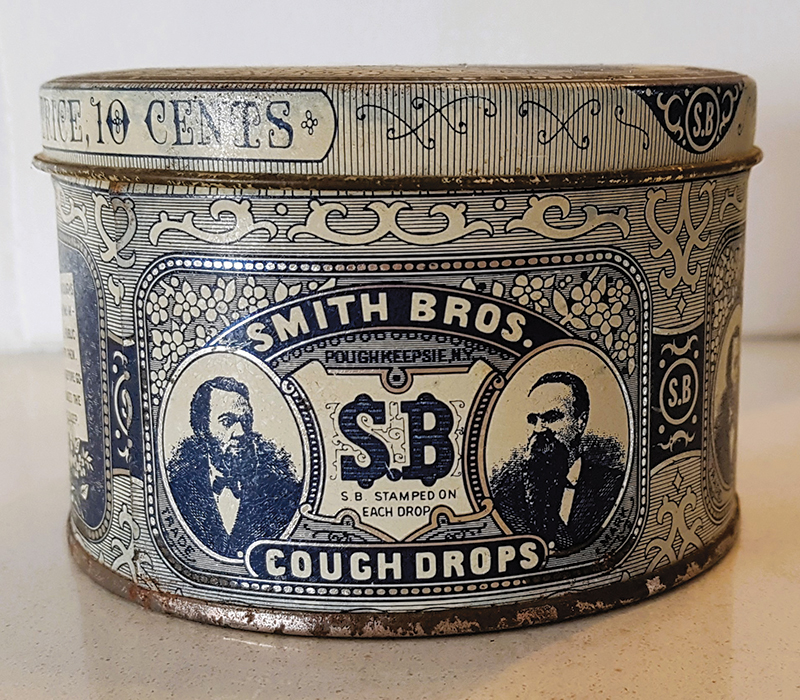Pardon My Cough

Un texte de Heather Darch
Paru dans le numéro Printemps/Spring 2023
Publié le : 17 février 2023
Dernière mise à jour : 17 février 2023
The first mass-produced Smith Brothers cough drops were created by a family who once called Missisquoi County home.
“Consumption,” otherwise known as tuberculosis, was the leading cause of mortality throughout Lower Canada by the mid 1700s. It was a terrible illness, often drawn out over years, that began with a simple cough, but ended with fever, a visible wasting away of the body “the forehead covered with drops of sweat; the cheeks painted with a livid crimson, the eyes sunk…the breath offensive, quick and laborious, and the cough so incessant as to scarce allow the wretched sufferer time to tell his complaints.”
Home remedies
Stopping a cough before it settled into the lungs was considered the first defence against consumption. It was the primary goal of physicians and homemakers alike to sooth scratchy throats and as a result, a wide range of odd home remedies and doctor recommended treatments like wearing mustard plasters while horseback riding were prevalent. Using spiced syrups, honey, and herbal teas to control coughing has long been a recognized remedy. The 2nd century Greek diagnostician Galen advocated for a mixture of “Pontic rhubarb, Cilician crocus saffron, opium, frankincense, myrrh, Celtic nard, and storax all administered with honey mixed with wine.” It was not until the 19th century however, that throat lozenges were developed. The first mass-produced cough drops were created by a family who once called Missisquoi County home.
A multi-talented man
James Smith (1805-1866) and his wife Ann Anderson (1808-1890), emigrated from Scotland to Lower Canada in 1831 along with their son William. For several years, they lived in Quebec City where their second son was born and by 1836, they lived in St. Hilaire, Quebec where third son Andrew was born. Shortly after, the family settled in St. Armand West (Frelighsburg) and welcomed three more children.
For over ten years, the family lived here. Smith primarily worked as a joiner and carpenter and was apparently quite a good one. An example of his craftsmanship is still to be seen in the carved beams of the John Krans house near Frelighsburg. In the 1842 Census for Missisquoi County, Smith was identified as a joiner, but he was also known as a confectioner. In fact, it has been said that he was long remembered in the community for his “splendid candy pulls.”
Moving to the States
In 1848, the Smiths made their final move to the market town of Poughkeepsie, New York where James established a restaurant, ice-cream parlour and candy business. It was in his capacity as a candymaker that he created a licorice elixir recipe used to make throat lozenges. His early “throat candies” were displayed in glass containers and dispensed in plain paper envelopes. By 1852, he advertised that “all persons troubled with coughs, colds, hoarseness, sore throat & etc., will find immediate relief by using these drops.”
By the mid 1850s, the “James Smith & Sons Sweet Shop,” signalled William and Andrew’s commitment to the business. When James died in 1866, they renamed the business “Smith Brothers,” relocated operations, and established the world’s first cough drop factory.
A pop cultural reference
Smith Brothers also developed the first factory-filled packages on the market. In an effort to keep other similar brands from imitating their product, they trademarked their drops in 1877 and adorned the packaging with their whiskered profiles. The word “Trade” appeared under the picture of William and the word “Mark” under Andrew. Soon the brothers became known by the nicknames Trade and Mark. The company’s staunch defense of its trademark made the Smiths’ faces among the most famous in America. Their logo became a pop cultural reference. At one time, the company kept sets of fake beards to outfit people who wished to attend costume parties as “Trade” or “Mark” Smith. Knowing they had a good thing going, the brothers never shaved.
Still up and running
Andrew died in 1895, and William continued as president until his death in 1913. He was succeeded by his son who added menthol drops to the production line in 1922, cough syrup in 1926, and wild cherry drops in 1948.
The Smith Brothers faced competition over the years as a variety of manufacturers developed their own formulas. Some even adding morphine, heroin and formaldehyde to tablets. At its height in the 1890s, Smith Brothers dominated the field. They made 60 tons of “natural and pure” cough drops – one million packages – a day.
The business was sold in 1963 and operations were shifted to Rockford, Illinois, that same year. But to this day, the fragrance of sugar, charcoal and licorice still lingers around the old plant. Smith Brothers products continue to be retailed throughout the U.S. and Canada. Proving that the little pastille first made in a kitchen could indeed relieve raspy throats and ease dreaded coughs.
Heather Darch
Sources
M. Friedman, As Temperatures Drop, Cough Remedies Flourish. Adweek (February, 1989).
Sadaf Ahsan, Consider the lozenge: Heroin, candy, and Halls, https://www.healthing.ca/wellness/consider-the-lozenge-heroin-candy-and-halls
The Smith Brothers Company https://smithbrothers.co/
U.S. and Canada, Passenger and Immigration Lists Index, 1500s-1900s [database on-line]. Provo, UT, USA: Ancestry.com
1843 Census for Lower Canada, Missisquoi, MG-31-C1, p.2600, image#172

